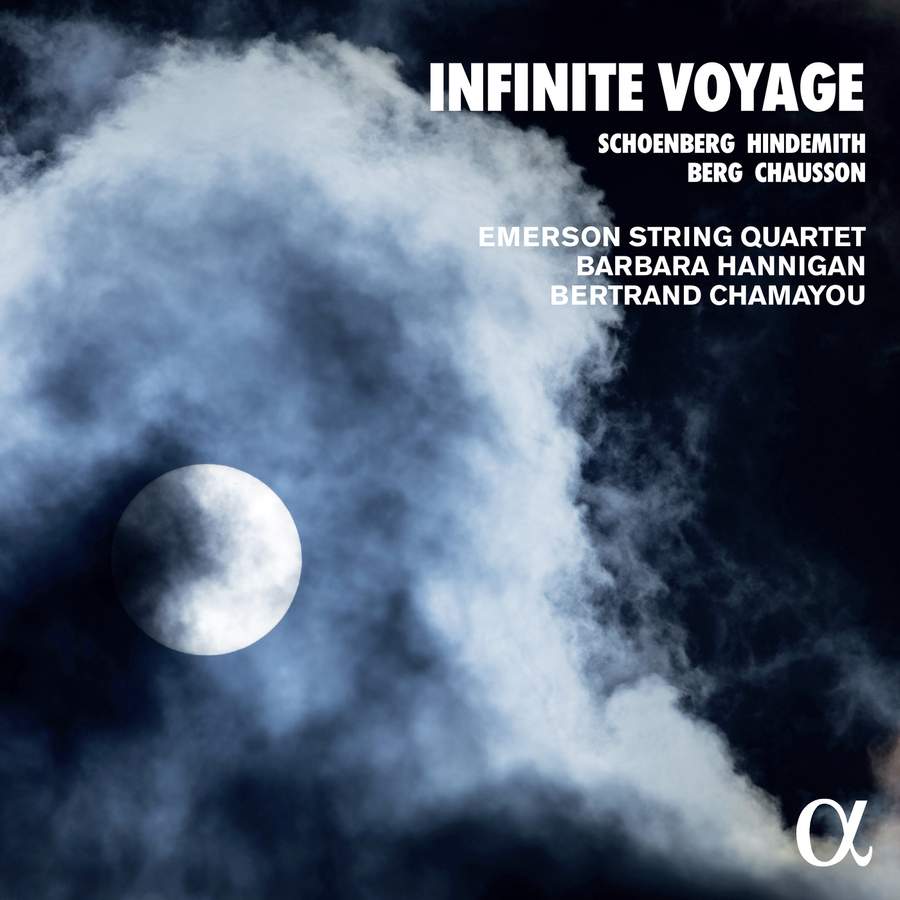Infinite Voyage
View record and artist detailsRecord and Artist Details
Genre:
Chamber
Label: Alpha
Magazine Review Date: 10/2023
Media Format: CD or Download
Media Runtime: 73
Mastering:
DDD
Catalogue Number: ALPHA1000

Tracks:
| Composition | Artist Credit |
|---|---|
| Melancholie |
Paul Hindemith, Composer
Barbara Hannigan, Soprano Emerson Quartet |
| String Quartet |
Alban Berg, Composer
Emerson Quartet |
| Chanson perpétuelle |
(Amedée-)Ernest Chausson, Composer
Barbara Hannigan, Soprano Bertrand Chamayou, Piano Emerson Quartet |
| String Quartet No. 2 |
Arnold Schoenberg, Composer
Barbara Hannigan, Soprano Emerson Quartet |
Author: Arnold Whittall
The Emerson Quartet’s farewell to recording on their retirement after a distinguished 40-year career is strikingly different from their Beethoven-Schubert farewell planned for the concert hall. Having excelled over the decades with their interpretations of 18th- and 19th-century classics, they have now joined forces with Barbara Hannigan for a programme including three 20th-century works, placing a pair of expressionistic string quartets alongside two rarely heard vocal pieces, less turbulent in texture but no less intense in their quite different ways.
Ernest Chausson is invariably pigeonholed as a French Wagnerian, and his Chanson perpétuelle (1897) comes across more as a dramatic scena than as a sequence of songs. It may well be even more dramatic in its version with orchestra, but the alternative accompaniment for piano and string quartet has ample depth of expression to fit with the flexibly balanced form of the whole. Its generic associations with lament are echoed in the four short sections of Hindemith’s Melancholie (1917 19), which sets poems by Christian Morgenstern to memorialise a friend of the composer’s killed in the First World War. Hindemith was only 22 when he began it, and the music has none of the bold, brash style he exploited during the 1920s. Rather, it seems to foreshadow the luminous lyricism of his best later compositions, such as the Mathis der Maler opera and symphony.
It is in major works by Berg and Schoenberg that the Emerson Quartet come to the fore, with recordings of admirable clarity in the most convoluted of textures and with all their special ability to project the full richness and seriousness of the musical material. Berg’s Op 3 (1910) may be a student work but as a deeply personal response to the romantic complications of his early life it embodies a remarkable tussle between overflowing emotion and the kind of rigorous attention to matters of technique and execution insisted on by his mentor Schoenberg. This early quartet could also reflect Berg’s reactions to his teacher’s own recent second quartet (1907 08), deeply entangled as this is with Schoenberg’s marital torments at the time of his wife’s liaison with the expressionist painter Richard Gerstl. Not content with sardonically introducing into the second movement the street song ‘Ach, du lieber Augustin’, which declares ‘all is lost’, Schoenberg abandoned the quartet genre’s hitherto fixed identity in two final movements, calling for a dramatic soprano to declaim the despairing then ecstatic texts by Stefan George in which phrases such as ‘I am dissolved in swirling sounds’ and, even more enigmatically, ‘I am only a roaring of the holy voice’ are matched with an almost hysterical euphoria – sounds that adumbrate but then step back from a radically new kind of music.
Just how radical to be, and just how new, Schoenberg would spend the rest of his composing life confronting. But no singer in Op 10 can surpass Barbara Hannigan in anatomising its searing mix of primitive and spiritually aspiring states of mind, matched to the hilt by the Emerson’s close-knit delineation of the massed shards of motivic elements the music throws out in its quest for transcendence. Perhaps the most memorable characteristic of this interpretation of a much-recorded work is the sense it gives of an overwhelming emotional implosion. The Emersons come to the score as if it were new, hot from the press, and in doing so they recreate the sense of inordinate extravagance that made early audiences so uneasy. In particular, the return to tonal, instrumental sanity at the end – the voice silent – seems more than usually provisional, impossible to imagine as able to persist for very long beyond this supremely unstable conclusion. The Emerson Quartet could hardly have chosen a more appropriate composition to encapsulate the special achievements as well as the endless challenges of their chosen medium.
Discover the world's largest classical music catalogue with Presto Music.

Gramophone Digital Club
- Digital Edition
- Digital Archive
- Reviews Database
- Full website access
From £8.75 / month
Subscribe
Gramophone Full Club
- Print Edition
- Digital Edition
- Digital Archive
- Reviews Database
- Full website access
From £11.00 / month
Subscribe
If you are a library, university or other organisation that would be interested in an institutional subscription to Gramophone please click here for further information.




